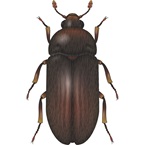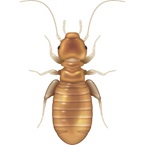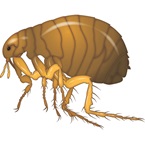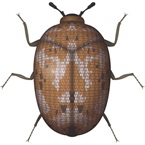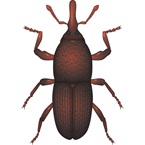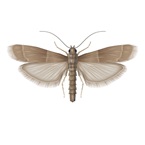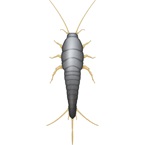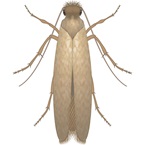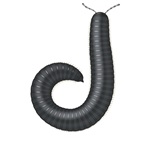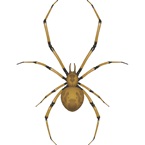Arthropods with a sac-like body ranging from 3-30mm long. They are the largest Acarines. The head, thorax and abdomen are closely fused and unsegmented. The body consists of the idiosoma and the gnathosoma (capitulum) with mouthparts consisting of a pair of chelicerae for cutting the skin of hosts, a central hypostome (beak) armed with recurved teeth which help to anchor the tick to its host and a pair of sensory palps. The idiosoma is membranous or leathery and sometimes
equipped with a scutum (shield). There is one pair of stigmata (eyespot) with a stigmal plate near the legs. Adults are typically eight-legged. There are two major families:
Ixodidae, Hard Ticks.
With a dorsal scutum which covers the whole dorsal surface in males but only developed anteriorly in females to permit distension of the body with blood and eggs. The hind end of the scutum is sometimes grooved. There is a prominent gnathosoma which is visible from above. The stigmata are situated behind coxae IV.
A pulvillus (sticky pad) is situated at the extremity of each leg. Examples are:
Brown Dog Tick (Rhipicephalus sanguineus)
Hedgehog Tick(Ixodes hexagonus)
Castor Bean Tick, Sheep Tick(Ixodes ricinus)
Argasidae, Soft Ticks
No scutum and mouthparts not visible from above. The cuticle is granulated and appears shrivelled when the tick is starved. The stigmata are usually located between coxae III and IV. There is no pulvillus (sticky pad) on the extremity of each leg.
Pigeon Argas (Argas reflexus)
Body ca 4.0mm long with granulations and small discs. Thin margin around idiosoma flexed upwards with striations on margin.
Areas where found:
There are over 850 species of tick. They are all blood-sucking parasites of vertebrates, principally mammals and birds but sometimes reptiles and amphibians. They are cosmopolitan and distributed across a wide range of habitats. Ticks can survive long periods of starvation which is a useful characteristic where hosts are limited. Periods of starvation ranging from 3-21 months have been variously quoted for nymphs and adult Rhipicephalus spp. and Ixodes spp. whilst A.reflexus is reported to be capable of surviving for at least five years without food. The Ixodidae are usually active by day and are typically three-host ticks, the larvae, nymphs and adults all spending time, often separated by extended periods, on different hosts. They are referred to as “ticks of the host” because they spend much of their active life on hosts. The adult females typically feed only once. By contrast the Argasidae ticks frequent the habitats of their hosts. They are nocturnal and typically take small meals from a number of hosts. They are referred to as “ticks of the habitat.”
R. sanguineus is encountered between 35°S and 50°N. It is found in cracks and crevices in buildings and is particularly associated with dogs. In Europe it can survive outdoors only in the summer and is best adapted to the warm dry environments encountered indoors. Humans may be attacked.
I. hexagonus is principally encountered in the burrows of its host which provide stable temperature and humidity conditions. It is not generally associated with buildings. Hosts include hedgehogs, foxes, cats and dogs. Humans may also occasionally be attacked.
I. ricinus is encountered in Europe to about 65°N. In urban areas it is associated with parks and gardens etc where it is limited by the availability of hosts. An humidity in excess of 80% RH is required for incubation and this can be found in the leaf litter of temperate deciduous forests and in conifer forests where the rainfall is sufficiently high. Hosts include sheep, deer, foxes, hedgehogs and birds. Humans may also be attacked. Small mammals and birds are only host to immature forms. The walking range of the tick does not exceed 15m so dispersal is achieved by way of the hosts and, in particular birds that forage on the ground.
A. reflexus is encountered in Europe to about 55°N where it is dependent for its survival upon elevated urban temperatures compared with the surrounding areas. It is particularly associated with pigeons and, as a result is associated with attics. Harbourages are found in crevices of buildings and furnishings. Pigeons are the principle host but other avian and mammalian species may be involved. Humans may also be attacked. The tick will only walk ca 10m and, because the larval blood meal takes six to eleven days it is thought dispersal is principally achieved by the feeding larva.
Importance as a pest:
The need to take blood meals makes ticks important in terms of nuisance, the direct effect loss of blood has on a host and their potential to act as vectors of disease. Tick bites as such are not generally serious. Anti-coagulin agents in tick saliva can, however, lead to haemorrhages. Heavy infestations of A.reflexus can cause the death of pigeons as a result of the loss of blood. In some cases the skin reacts to form a cup-like cyst which will cover the tick. Particular problems occur where the bites cause irritation or become infected. I. ricinus will bite man, I. hexagonus only rarely bites man whilst A. reflexus bites pigeons in preference to man. Tick paralysis can arise from the bite of ticks such as I. ricinus. It is caused by toxic saliva produced when females are developing eggs rapidly. Ascending motor nerve paralysis can lead to death when respiratory muscles are affected. If the ticks are removed at an early stage recovery is generally rapid. The problem has been recorded in Europe in cattle and sheep and there is a potential threat to children depending in part where the bite occurs. Ticks can transmit a variety of diseases and arise particularly from wild animal reservoirs. The ticks are not affected by the pathogens. The following are examples of some diseases which are encountered in Europe:
|
Virus Central tick borne encephalitis Louping ill |
Tick species I. ricinus I. ricinus |
|
Rickettsial diseases Boutonneuse fever |
Ixodes spp. |
|
Spirochaetes Lyme disease |
I. ricinus |
Lifecycle:
Female Ixodidae ticks feed once increasing body weight up to 150 times. A large batch of eggs, globular, light brown and shiny in appearance is then laid in suitable harbourages and covered with a secretion to reduce dessication. The female then dies. The eggs hatch to yield 6-legged larvae which cling to vegetation awaiting a
passing host. The whole brood may attach to the same host. When fully fed the larva drops to the ground and eventually moults to form an 8-legged nymph. Some species, the one host ticks, spend their entire life on a single host. Otherwise the process of attaching to the host will be repeated by the nymph and subsequently the adult. There is only one nymphal stage in the Ixodidae. The process is governed by temperature and the availability of hosts and may last several years. The opportunity to take three substantial blood meals means that given optimal conditions the life cycle could be completed in approximately six months so numbers of ticks eg. R. sanguineus could build up very quickly. In the case of the Argasidae ticks the females feed at intervals only increasing their body weight by up to three times. The globular, dark brown shiny eggs are then laid in batches of 20-50. The 6-legged larvae feed on the hosts for six to eleven days although the 8-legged nymphs and adults only feed for up to 12 hours. The nymphs may moult up to eight times. Those of some species produce a coxal fluid. It is believed to be
separated plasma from the blood meal and may be infected with pathogens. The process is governed by temperature and the availability of hosts and extends from two to four years.
Control:
The method adopted for the control of ticks will depend upon the species involved and its distribution. Ixodidae ticks infesting areas outdoors can be detected by dragging a light coloured woollen blanket through potentially infested vegetation. Larva, nymph and adult forms will appear as small dark spots. Protective clothing is important for those working outdoors in areas known to be infested with ticks. Clothing can be treated with suitable repellents. Boots and trousers should be worn and the trousers tucked into socks. Frequent inspections should be made to ensure that ticks have not attached themselves. If ticks are found attached to the skin care should be taken when removing them to ensure the capitulum does not remain behind. They can be removed by touching them with a suitable volatile solvent pressing them inwards to disengage the teeth before removing them. Alternatively they can be soaked with medicinal paraffin or olive oil and removal attempted some hours later. The wide distribution of ticks outdoors means control measures are usually limited to restricted areas eg parks and other recreational areas. The availability of resting sites and the habitats of hosts can be restricted by cutting vegetation and removing debris. Infested vegetation can be treated with suitable insecticides exhibiting acaricidal and residual activity. It is important to ensure adequate penetration and coverage of the vegetation. Ixodidae ticks may be controlled by treating hosts whilst the Argasidae ticks are typically controlled by treatment of the habitat ie the harbourages of the ticks.





